While the reality of building a viable business based on a mobile app is daunting, that’s not stopping tens of thousands of apps from launching every week. To compete with millions of live apps in Google Play and the Apple App Store, mobile app developers and marketers are looking for every possible advantage.
Why Content is Important to Your Mobile Analytics
To build a business, you have to first understand how it’s performing. For mobile apps, this means integrating a mobile analytics provider. But in a world in which in-app content will become more and more crucial to building a viable mobile business, how can you understand which content drives app performance?
In this post, we’ll briefly review why mobile analytics matters and how app developers can start looking at content analytics to improve their user acquisition strategy.
The Use of App Analytics
Users spend 85% of their time on mobile devices in mobile apps. By understanding how that time is spent in an app, developers can unlock a treasure trove of insights that can provide a critical competitive advantage. Because the insights are so valuable, a rush of companies moved into the space to help app developers and marketers track user behavior and slice it and dice it in any number of ways.
This isn’t a discussion of the top mobile analytics providers. But if you’re looking for a discussion of which one to choose, there are a litany of blog posts and analyst reports that provide snapshots of analytics vendors and the services they provide.
Regardless of which service selected, these features are the most commonly found:
- User events: this is how analytics providers understand what users do in their app. They’re used to track things like user path flow and purchases.
- Engagement, retention and monetization analysis: understand how events impact whether users use, continue to use, and spend money or earn you money in your application.
- Funnels: use event data to track the conversion of users through any of a designated number of steps. Typically used to evaluate performance of features like onboarding flows, billing information flows, and levels in apps like games.
- Segmentation: build segments of on user dimensions (i.e., gender, nationality, money spent) and user events to understand which groups of users are most important and how they use the app differently.
- User acquisition analytics: determine which channels and campaigns are the sources of the best users.
The Importance of Content Performance
Apps are amazing sources of unique content — news stories, songs, recipes, photos, and more. Branch recently ran tests to determine the impact of using app content in marketing promotions and the results were astounding. We saw decreases in user acquisition costs (up to 50%) and improvements in user engagement (up to 3x increase).
So why don’t analytics providers track the views, clicks, installs, etc. generated by that content outside of the app and tie it to important user behavior like money spent?
Deep Linking is Necessary to Understand Content Performance
To understand how in-app content performs, a mobile analytics system would need to be able to track performance of an individual item, like a news article, across multiple channels. This requires deep linking.
However, traditional mobile analytics providers typically do not offer deep linking. This is the result of a combination of factors. First, building a deep linking system that works properly and tracks clicks across the various standards is a non-trivial undertaking. Second, when most mobile analytics providers came into existence, tracking this type of information wasn’t relevant to app developers and marketers. Linking to app content just wasn’t done because linking to content after install wasn’t possible and created terrible user experiences.
Recent innovations in deep linking, (specifically contextual deep linking by companies like Branch,) have made for incredible gains in user experiences for mobile content marketing. Deep links now take users directly to the content in an app if it’s installed and will even open the same app content if they have to install the app after clicking on the link.
As more app developers and marketers deploy content in their mobile marketing efforts, it will become crucial to understand how it contributes to an app’s business.
Content Analytics for App Content
Branch introduced Content Analytics to specifically solve this problem. Because it is built on our deep linking platform, Content Analytics is able to provide valuable data like views, links created, link clicks, installs, and opens, for individual pieces of app content.
This helps app developers and marketers understand how individual pieces perform and measure growth at a channel-level (e.g. comparing the number of installs driven by a piece of content on Twitter versus Facebook).
When this type of data is passed along to a mobile analytics provider (like our partner Localytics), app developers can unlock deeper insights like identifying which app content appeals to different user segments and generates the most revenue.
How Do I Start Using Content Analytics?
If you’re already using Branch to deep link to content, Branch will automatically track and report links created, link clicks, installs, and opens at the content level. This data will be available on the Branch dashboard for partners using some of our most popular features including content sharing, referrals, or smart banners.
In order to see content-level views in Content Analytics, you need to install the new Branch SDK for iOS or Android. From there, incorporate the BranchUniversalObject and use it for the functions ‘registerView’. We’ve dedicated a page on our documentation portal to walk you through the migration to Content Analytics.
Like all Branch products, Content Analytics is completely free. Use the button below to see how your app content is performing.
























